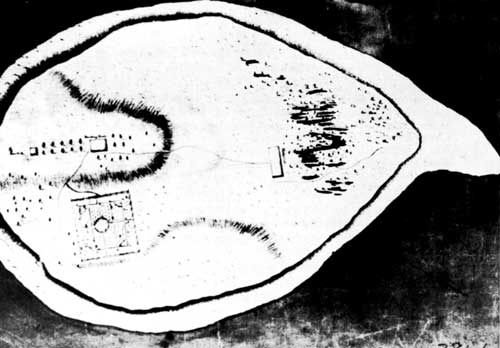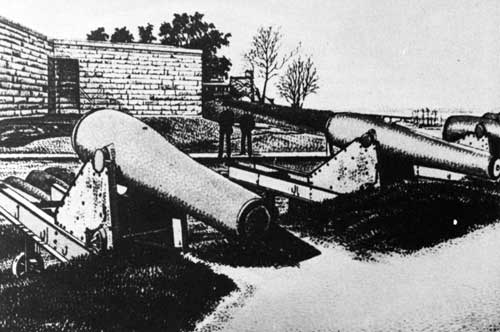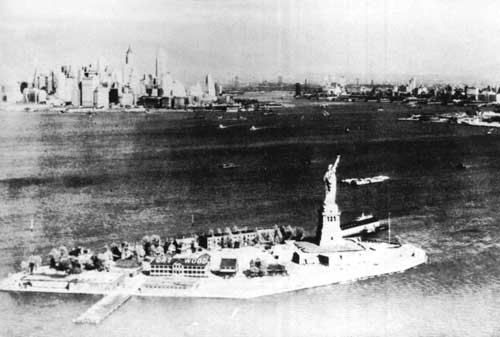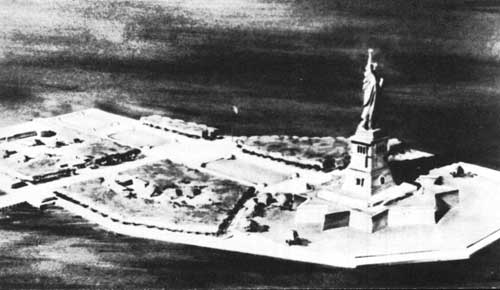|
STATUE OF LIBERTY National Monument Bedloe's Island, New York |
 |
Early History of
Bedloe's Island

Bedloe's Island, 1772.
BEDLOE'S ISLAND, one of a group of islands in New York Harbor near the mouth of the Hudson River, has had a long and interesting history. Over it have flown the flags of Holland, England, and the United States; and for a brief time it was lent to the French Government. It has also belonged to the corporation of New York City, to the State, and to several private owners.
The Mohegan Indians called it "Minnissais, meaning Lesser Island. At various times it has been known as "Great Oyster," "Love Island," "Bedloo's Island," "Kennedy's Island," "Corporation Island," "Bedlow's Island"—an anglicized form of the original owner's name—and now "Bedloe's," a spelling for which there is no historical basis.
Under Dutch sovereignty the island became the property of Isaack Bedloo, merchant and "select burgher" of New Amsterdam, who was born in Calais, France. His name was listed with 94 others in the "Remonstrance of the People of New Netherlands to the Director-General and Council"—a protest of public-spirited citizens to Holland against certain intolerable conditions. So it was not surprising that under English rule the island was formally granted to him by Governor Nicolls of New York.
Bedloo is believed to have died in 1673. His estate retained the island until 1732, when his daughter Mary sold it to Adolphe Philipse and Henry Lane for 5 shillings. During their ownership the island was temporarily commandeered as the first quarantine station by the city, which feared "that small-pox and other malignant fevers may be brought in from South Carolina, Barbadoes, Antigua, and other places, where they have great mortality."
In 1746, Archibald Kennedy bought the island for the sum of £100, for use as a summer home. During his ownership the State ordered the erection of a beacon on Bedloe's Island, for the purpose of warning New Jersey, Connecticut, and New York of the approach of an enemy.
In 1756, the Governor of New York instructed Kennedy, as presiding councillor of New York, to exercise all possible. precautions to prevent the introduction of smallpox, which was then raging in Philadelphia. Kennedy permitted the use of his island again as a temporary quarantine station. In 1759, the Corporation of the City of New York bought the island for £1,000 to erect a pest-house. During the next few years it was leased to several different persons for varied periods of time.
When the English occupied New York they seized Bedloe's Island and used it as a refuge for Tory sympathizers. Objecting to this use, rebels managed to set fire to all the buildings on the island and to do other damage.
The French came into the picture in 1793, using Bedloe's Island as an isolation station for 3 years. In 1796, the island was conveyed to the ownership of New York State for use as a hospital site or any other desired purpose.
By this time steps had been taken by the newly organized Federal Government, in conjunction with the State, to erect fortifications to protect New York Harbor. Three sites—Governor's Island, Ellis Island, and Bedloe's Island—were chosen for defense fortifications, and on February 15, 1800, by act of the New York Legislature, the three islands were ceded to the United States Government.

Outer battery, Fort Wood, 1890.
Construction of a land battery, in the shape of an 11-point star, was begun on Bedloe's Island in 1806 and finished 5 years later. For a while referred to merely as the "works on Bedloe's Island," it later was named "Fort Wood" in memory of a distinguished hero of the War of 1812 who was killed in 1814 during an attack on Fort Erie.
Following the War of 1812, Fort Wood served at various times as a Corps of Artillery garrison, ordnance depot, and recruiting station, and intermittently as a quarantine station.

Fort Wood, 1939.
Then came Bartholdi and his great idea, and in 1877 Bedloe's Island was chosen as the site for the Statue of Liberty Enlightening the World. Although the island was then abandoned as a military post, it remained under the control of the War Department, with the exception of an acre or so at its north end which was set aside for the Lighthouse Board which operated the light in the torch. In 1901, the lighthouse reservation also was placed under War Department control.

Perspective view of Bedloe's Island showing
development plan.

|

|
|
Last Modified: Tues, Sep 25 2000 10:00:00 pm PDT |


